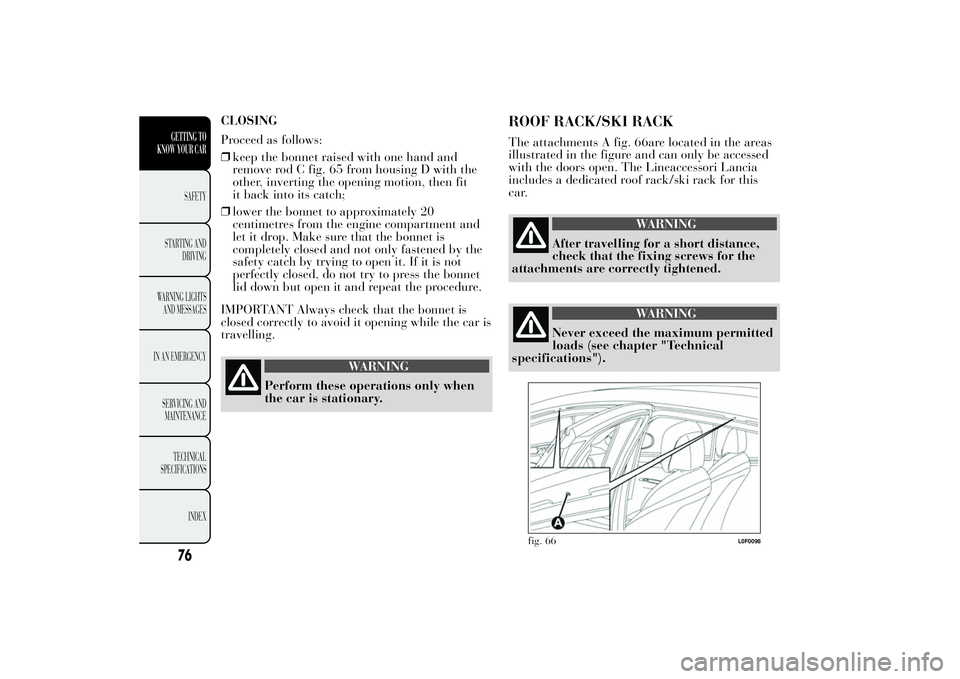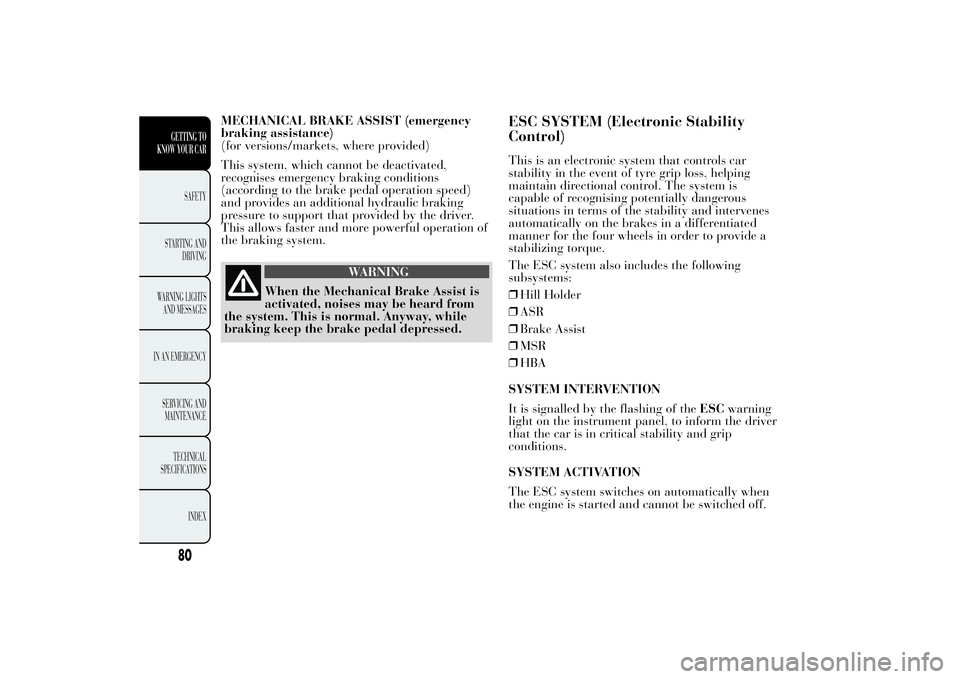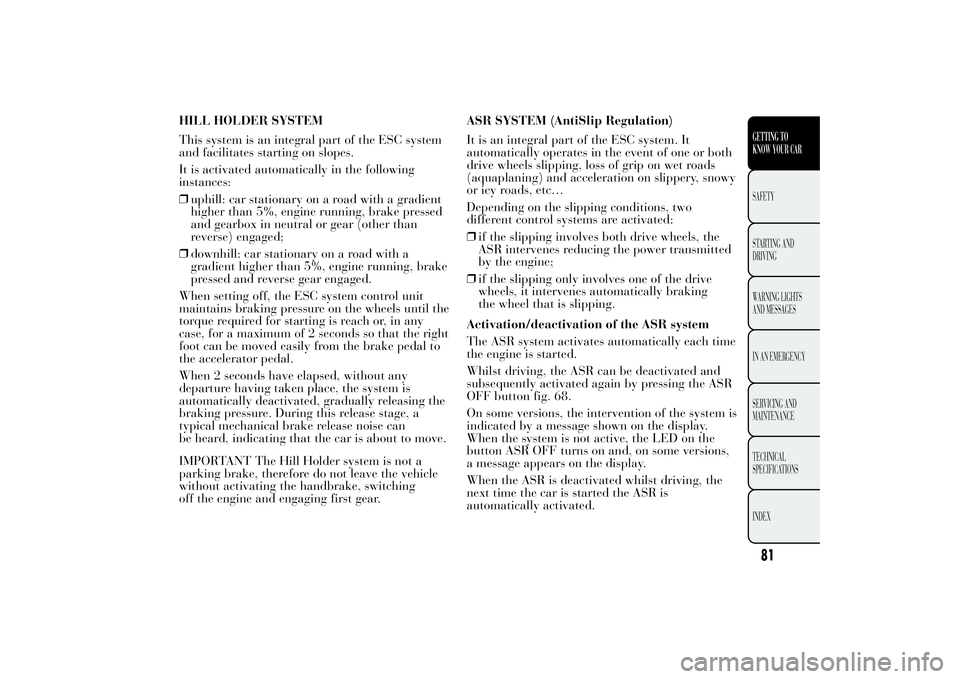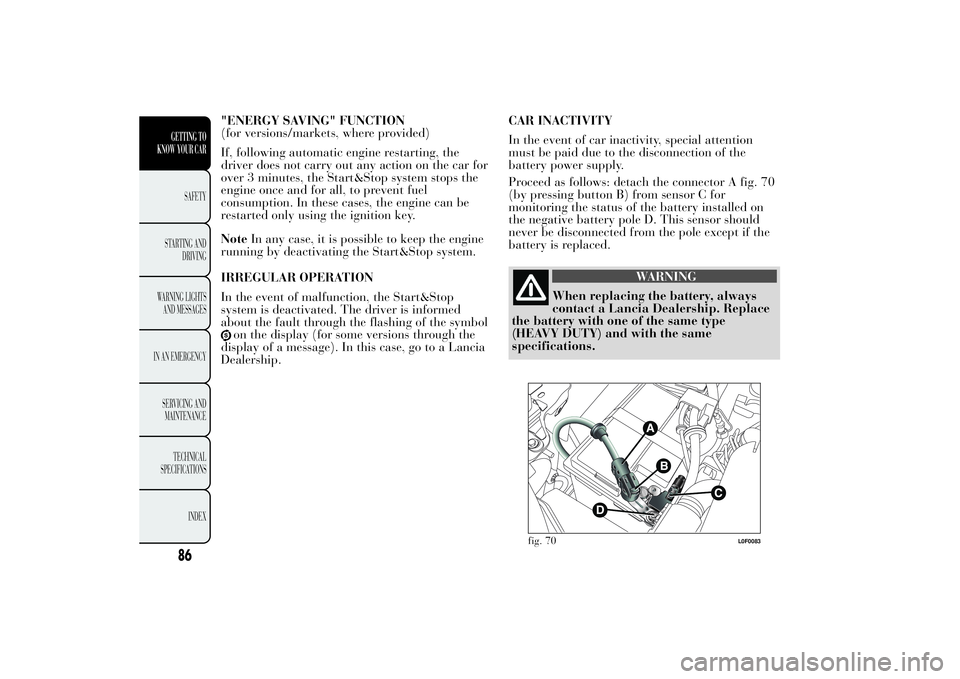engine Lancia Ypsilon 2011 Owner handbook (in English)
[x] Cancel search | Manufacturer: LANCIA, Model Year: 2011, Model line: Ypsilon, Model: Lancia Ypsilon 2011Pages: 299, PDF Size: 13.35 MB
Page 63 of 299

FUEL CUT-OFF SYSTEM
This intervenes in the case of an impact causing:
❒the interruption of the fuel supply with the
engine consequently cutting out
❒the automatic unlocking of the doors
❒the automatic switching on of the interior lights
❒the switching on of the hazard warning lights.
On some versions, the intervention of the system is
indicated by a message shown on the display.
IMPORTANT Carefully check the car for fuel
leaks, for instance in the engine compartment,
under the car or near the tank area. After a
collision, turn the ignition key to STOP to prevent
the battery from running down.
To restore the correct operation of the car, proceed
as follows:❒turn the ignition key to the MAR position;
❒activate the right direction indicator;
❒deactivate the right direction indicator;
❒activate the left direction indicator;
❒deactivate the left direction indicator;
❒activate the right direction indicator;
❒deactivate the right direction indicator;
❒activate the left direction indicator;
❒deactivate the left direction indicator;
❒turn the ignition key to the STOP position.
WARNING
If, after an impact, you smell fuel or
notice leaks from
the fuel system,
do not reactivate the system to avoid the risk
of fire.
fig. 47
L0F0039
61GETTING TO
KNOW YOUR CARSAFETY
STARTING
AND
DRIVING
WARNING LIGHTS
AND MESSAGES
IN AN EMERGENCY
SERVICING AND
MAINTENANCE
TECHNICAL
SPECIFICATIONS
INDEX
Page 78 of 299

CLOSING
Proceed as follows:
❒keep the bonnet raised with one hand and
remove rod C fig. 65 from housing D with the
other, inverting the opening motion, then fit
it back into its catch;
❒lower the bonnet to approximately 20
centimetres from the engine compartment and
let it drop. Make sure that the bonnet is
completely closed and not only fastened by the
safety catch by trying to open it. If it is not
perfectly closed, do not try to press the bonnet
lid down but open it and repeat the procedure.
IMPORTANT Always check that the bonnet is
closed correctly to avoid it opening while the car is
travelling.
WARNING
Perform these operations only when
the car is
stationary.
ROOF RACK/SKI RACKThe attachments A fig. 66are located in the areas
illustrated in the figure and can only be accessed
with the doors open. The Lineaccessori Lancia
includes a dedicated roof rack/ski rack for this
car.
WARNING
After travelling for a short distance,
check that the
fixing screws for the
attachments are correctly tightened.
WARNING
Never exceed the maximum permitted
loads (see chapter
"Technical
specifications").
fig. 66
L0F0098
76GETTING TO
KNOW YOUR CAR
SAFETY
STARTING
AND
DRIVING
WARNING LIGHTS
AND MESSAGES
IN AN EMERGENCY
SERVICING AND
MAINTENANCE
TECHNICAL
SPECIFICATIONS
INDEX
Page 82 of 299

MECHANICAL BRAKE ASSIST (emergency
braking assistance)
(for versions/markets, where provided)
This system, which cannot be deactivated,
recognises emergency braking conditions
(according to the brake pedal operation speed)
and provides an additional hydraulic braking
pressure to support that provided by the driver.
This allows faster and more powerful operation of
the braking system.
WARNING
When the Mechanical Brake Assist is
activated, noises may
be heard from
the system. This is normal. Anyway, while
braking keep the brake pedal depressed.
ESC SYSTEM (Electronic Stability
Control)This is an electronic system that controls car
stability in the event of tyre grip loss, helping
maintain directional control. The system is
capable of recognising potentially dangerous
situations in terms of the stability and intervenes
automatically on the brakes in a differentiated
manner for the four wheels in order to provide a
stabilizing torque.
The ESC system also includes the following
subsystems:
❒Hill Holder
❒ASR
❒Brake Assist
❒MSR
❒HBA
SYSTEM INTERVENTION
It is signalled by the flashing of theESCwarning
light on the instrument panel, to inform the driver
that the car is in critical stability and grip
conditions.
SYSTEM ACTIVATION
The ESC system switches on automatically when
the engine is started and cannot be switched off.
80GETTING TO
KNOW YOUR CAR
SAFETY
STARTING
AND
DRIVING
WARNING LIGHTS
AND MESSAGES
IN AN EMERGENCY
SERVICING AND
MAINTENANCE
TECHNICAL
SPECIFICATIONS
INDEX
Page 83 of 299

HILL HOLDER SYSTEM
This system is an integral part of the ESC system
and facilitates starting on slopes.
It is activated automatically in the following
instances:
❒uphill: car stationary on a road with a gradient
higher than 5%, engine running, brake pressed
and gearbox in neutral or gear (other than
reverse) engaged;
❒downhill: car stationary on a road with a
gradient higher than 5%, engine running, brake
pressed and reverse gear engaged.
When setting off, the ESC system control unit
maintains braking pressure on the wheels until the
torque required for starting is reach or, in any
case, for a maximum of 2 seconds so that the right
foot can be moved easily from the brake pedal to
the accelerator pedal.
When 2 seconds have elapsed, without any
departure having taken place, the system is
automatically deactivated, gradually releasing the
braking pressure. During this release stage, a
typical mechanical brake release noise can
be heard, indicating that the car is about to move.
IMPORTANT The Hill Holder system is not a
parking brake, therefore do not leave the vehicle
without activating the handbrake, switching
off the engine and engaging first gear.ASR SYSTEM (AntiSlip Regulation)
It is an integral part of the ESC system. It
automatically operates in the event of one or both
drive wheels slipping, loss of grip on wet roads
(aquaplaning) and acceleration on slippery, snowy
or icy roads, etc…
Depending on the slipping conditions, two
different control systems are activated:
❒if the slipping involves both drive wheels, the
ASR intervenes reducing the power transmitted
by the engine;
❒if the slipping only involves one of the drive
wheels, it intervenes automatically braking
the wheel that is slipping.
Activation/deactivation of the ASR system
The ASR system activates automatically each time
the engine is started.
Whilst driving, the ASR can be deactivated and
subsequently activated again by pressing the ASR
OFF button fig. 68.
On some versions, the intervention of the system is
indicated by a message shown on the display.
When the system is not active, the LED on the
button ASR OFF turns on and, on some versions,
a message appears on the display.
When the ASR is deactivated whilst driving, the
next time the car is started the ASR is
automatically activated.
81GETTING TO
KNOW YOUR CARSAFETY
STARTING
AND
DRIVING
WARNING LIGHTS
AND MESSAGES
IN AN EMERGENCY
SERVICING AND
MAINTENANCE
TECHNICAL
SPECIFICATIONS
INDEX
Page 85 of 299

MSR SYSTEM
(Motor Schleppmoment Regelung)
This system is an integral part of the ABS, that
intervenes, if there is sudden downshifting,
restoring torque to the engine, thereby preventing
excessive drive at the drive wheels which,
especially in poor grip conditions, could lead to a
loss in stability of the car.
START&STOP SYSTEMINTRODUCTION
The Start&Stop system automatically stops the
engine each time the car is stationary and starts it
again when the driver wants to move off. In this
way, the car efficiency is increased, by reducing
consumption, dangerous gas emissions and noise
pollution.
The system activates every time the car is started.
OPERATING MODES
Engine stopping mode
With the car stopped, the engine stops with
gearbox in neutral and clutch pedal released.
NoteThe engine can only be stopped
automatically after driving at a speed of more
than about 10 km/h, to prevent the engine from
being repeatedly stopped when driving at walking
pace.
Symbol
appears on the display when the engine
stops.
83GETTING TO
KNOW YOUR CARSAFETY
STARTING
AND
DRIVING
WARNING LIGHTS
AND MESSAGES
IN AN EMERGENCY
SERVICING AND
MAINTENANCE
TECHNICAL
SPECIFICATIONS
INDEX
Page 86 of 299

Engine t mode
Press the clutch pedal to restart the engine.
MANUAL SYSTEM ACTIVATION/
DEACTIVATION
To activate/deactivate the system manually, press
the button
fig. 69 on the dashboard control
trim.
Start&Stop system activation
Start&Stop system activation is signalled by a
message on the display. In this condition, the LED
on the button
is off.
Start&Stop system deactivation
Versions with multifunction display: a message
appears on the display when the Start&Stop
system is deactivated.Versions with reconfigurable multifunction
display: the
symbol and a message appear on
the display when the Start&Stop system is
deactivated.
The LED above the
button is on when the
system is deactivated.
ENGINE STOPPING FAILURE CONDITIONS
When the system is active, due to comfort,
emission control and safety reasons, the engine
does not stop in some conditions, among which:
❒engine still cold;
❒especially cold outside temperature;
❒battery not sufficiently charged;
❒heated rear window activated;
❒windscreen wipers working at maximum speed;
❒particulate filter regeneration (DPF) in progress
(diesel engines only);
❒driver's door not shut;
❒driver's seat belt not fastened;
❒reverse gear engaged (for example, for parking
manoeuvres);
❒for versions equipped with automatic climate
control (for versions/markets, where provided),
if an adequate level of thermal comfort has
not been reached or with MAX-DEF activation;
❒during the first period of use, to initialise the
system.
fig. 69
L0F0044
84GETTING TO
KNOW YOUR CAR
SAFETY
STARTING
AND
DRIVING
WARNING LIGHTS
AND MESSAGES
IN AN EMERGENCY
SERVICING AND
MAINTENANCE
TECHNICAL
SPECIFICATIONS
INDEX
res arting
Page 87 of 299

In these cases, the display shows a message and -
for versions/markets, where provided - the symbol
flashes on the display.
If climate comfort is to be favoured, the
Start&Stop system can be disabled,
for a continuous operation of the
climate control system.
ENGINE RESTARTING CONDITIONS
For reasons of comfort, limiting harmful emissions
and safety purposes, the power unit can restart
automatically without any action on behalf of the
driver if certain conditions are met, including:
❒battery not sufficiently charged;
❒windscreen wipers working at maximum speed;
❒reduced braking system vacuum (e.g. if the
brake pedal is pressed repeatedly);
❒car moving (e.g. when driving on roads with a
gradient);
❒engine stopping by Start&Stop system for over
3 minutes;
❒for versions equipped with automatic climate
control (for versions/markets where provided),
to enable suitable thermal comfort or with
MAX-DEF activation.With gear engaged, automatic engine restarting is
possible only by fully depressing the clutch pedal.
The driver is informed by the displaying of a
message on the display and - for versions/markets,
where provided - by the flashing of the symbol
.
Notes
If the clutch is not pressed, 3 minutes after the
engine stops, the engine can be restarted only
using the ignition key.
In cases when the engine stops and this is not
desired, due for example to the clutch pedal being
released sharply with a gear engaged, if the
Start&Stop system is activated, the engine can be
restarted by fully depressing the clutch pedal or
by placing the gear lever in neutral.
SAFETY FUNCTIONS
When the engine is stopped by the Start&Stop
system, if the driver releases his/her seat belt and
opens the driver's or passenger's door, the engine
can be restarted only using the ignition key.
The driver is informed by a buzzer and by the
flashing of the symbol
on the display; on some
versions, a message is displayed as well.
85GETTING TO
KNOW YOUR CARSAFETY
STARTING
AND
DRIVING
WARNING LIGHTS
AND MESSAGES
IN AN EMERGENCY
SERVICING AND
MAINTENANCE
TECHNICAL
SPECIFICATIONS
INDEX
Page 88 of 299

"ENERGY SAVING" FUNCTION
(for versions/markets, where provided)
If, following automatic engine restarting, the
driver does not carry out any action on the car for
over 3 minutes, the Start&Stop system stops the
engine once and for all, to prevent fuel
consumption. In these cases, the engine can be
restarted only using the ignition key.
NoteIn any case, it is possible to keep the engine
running by deactivating the Start&Stop system.
IRREGULAR OPERATION
In the event of malfunction, the Start&Stop
system is deactivated. The driver is informed
about the fault through the flashing of the symbol
on the display (for some versions through the
display of a message). In this case, go to a Lancia
Dealership.CAR INACTIVITY
In the event of car inactivity, special attention
must be paid due to the disconnection of the
battery power supply.
Proceed as follows: detach the connector A fig. 70
(by pressing button B) from sensor C for
monitoring the status of the battery installed on
the negative battery pole D. This sensor should
never be disconnected from the pole except if the
battery is replaced.
WARNING
When replacing the battery, always
contact a Lancia
Dealership. Replace
the battery with one of the same type
(HEAVY DUTY) and with the same
specifications.
fig. 70
L0F0083
86GETTING TO
KNOW YOUR CAR
SAFETY
STARTING
AND
DRIVING
WARNING LIGHTS
AND MESSAGES
IN AN EMERGENCY
SERVICING AND
MAINTENANCE
TECHNICAL
SPECIFICATIONS
INDEX
Page 89 of 299

JUMP STARTING
When jump starting, never connect the negative
lead (-) of the auxiliary battery to the negative
pole A fig. 71 of the car battery, but rather to an
engine/gearbox earth point.IMPORTANT NOTES
WARNING
Before opening the bonnet, make sure
that the engine
is off and that the
ignition key is in the STOP position. Follow
the instructions on the dedicated label on the
front crossmember fig. 72. We recommend
that you remove the key from the ignition
if other people remain in the vehicle. Exit
from the car only after having removed the
ignition key or having rotated it to the STOP
position. During refuelling, make sure the
car has been stopped and the key is in STOP
position.
fig. 71
L0F0084
fig. 72
L0F0204
87GETTING TO
KNOW YOUR CARSAFETY
STARTING
AND
DRIVING
WARNING LIGHTS
AND MESSAGES
IN AN EMERGENCY
SERVICING AND
MAINTENANCE
TECHNICAL
SPECIFICATIONS
INDEX
Page 90 of 299

EOBD SYSTEMThe EOBD system (European On Board
Diagnosis) carries out a continuous diagnosis of
the components of the car related to emissions. It
also alerts the driver about component
deterioration by switching on the warning light on
the instrument panel and the displaying of a
relevant message (for versions/markets, where
provided) (see the chapter “Warning lights and
messages”).
The aim of the EOBD system (European On Board
Diagnosis) is to:
❒monitor the system efficiency;
❒indicate an increase in emissions;
❒indicate the need to replace damaged
components.
The system also has a diagnosis connector that
can be interfaced to suitable instruments, to read
the error codes stored in the control unit together
with a series of specific parameters for engine
operation and diagnosis.
IMPORTANT After eliminating the failure, to
check the system completely, Lancia Dealerships
run a bench test and, if necessary, road tests which
may also call for a long journey.
DUALDRIVE ELECTRIC POWER
STEERINGThis only operates with the key turned to MAR
and the engine started. The steering allows the
force required at the steering wheel to be adjusted
to suit driving conditions.
IMPORTANT When turning the ignition key
quickly, full power steering functionality can be
achieved after a few seconds.
CITY FUNCTION ACTIVATION/
DEACTIVATION
Press button CITY fig. 73 to activate/deactivate
the function. The activation of the function is
signalled by the word CITY on the display (in
some versions it is signalled by the word CITY
appearing on the instrument panel).
fig. 73
L0F0082
88GETTING TO
KNOW YOUR CAR
SAFETY
STARTING
AND
DRIVING
WARNING LIGHTS
AND MESSAGES
IN AN EMERGENCY
SERVICING AND
MAINTENANCE
TECHNICAL
SPECIFICATIONS
INDEX